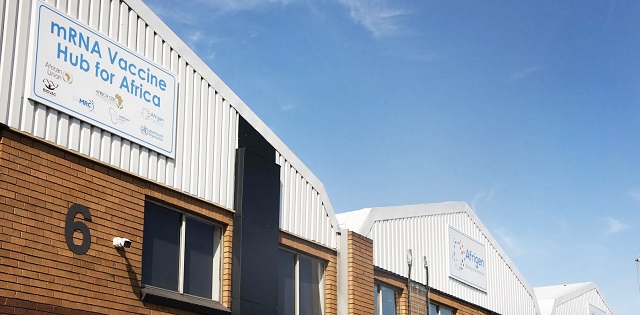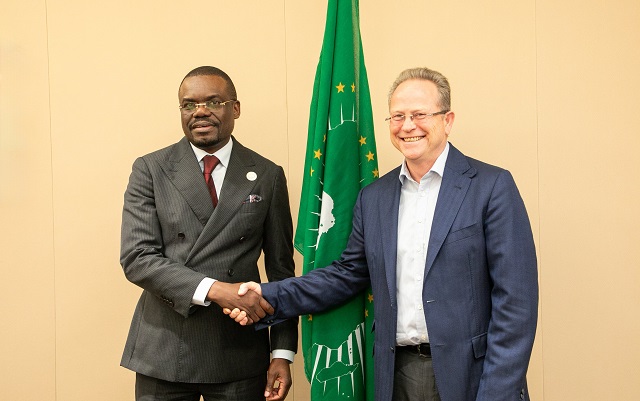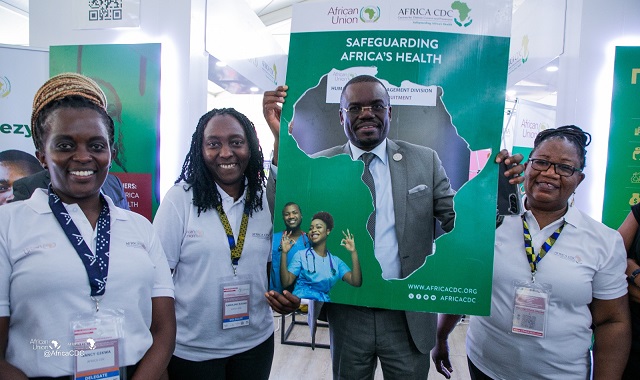
Local manufacturing of vaccines is Africa’s ‘second independence’ says Africa CDC boss
Lusaka, Zambia | RONALD MUSOKE | The African Union’s desire to ramp-up vaccine manufacturing on the continent has been boosted by a commitment in principle by GAVI, the Vaccine Alliance, to inject US$1 billion into the process.
Dr. Jean Kaseya, the Director General of the Africa Centres for Disease Control and Prevention (Africa CDC) revealed this at a media briefing on the opening day of the 3rd International Conference on Public Health that took place Nov.27-30 in Lusaka, Zambia.
The conference, the second biggest in the world after the World Health Organisation Assembly, was held under the theme, “Breaking Barriers: Repositioning Africa in the Global Health Architecture.”
It brought together researchers, policymakers, health ministers, among others, from Africa and the entire world to share scientific findings and collaborate on research in the continent’s quest to improve its health security.
Kaseya said the African Union (AU) is working with partners such as the EU and GAVI, the Vaccine Alliance, and that US$1 billion was approved by the policy committee of GAVI. He said it will be tabled to the Board during a meeting in Ghana before the close of this year.
“That US$1 billion is for African manufacturing; it will help African (pharmaceutical) manufacturers to invest,” Dr. Kaseya said.
“Let me emphasise something I have to say every day; local manufacturing (of vaccines) is the second independence of Africa. I repeat it, local manufacturing is the second independence of Africa,” he said.
The Africa CDC is an autonomous body that is mandated with strengthening the capacity of African countries to respond quickly and effectively to disease threat. It says the African Union has a new public health order which seeks to increase the manufacture of vaccines, therapeutics and diagnostics as one of the continent’s pillars to ensure health security for its 1.4 billion people.
Dr. Kaseya said African countries learnt ‘a big lesson’ when it came to procuring COVID-19 vaccines during the pandemic. “Our countries got independence in 1960. But we saw with COVID-19 that Africa is not independent.”
Several themes on improving the health security of Africa were discussed during the conference, including: how to prepare for pandemics and create resilient financing mechanisms in Africa, fostering African-led innovation in order to advance local production of vaccines, diagnostics and therapeutics, and delivering universal health coverage in Africa (strengthening equitable health systems).
Other topics included: Accessing adequate health care for young girls and women in Africa, safeguarding Africa’s health security (health emergencies, bio-security, climate change and multi-sectoral response mechanisms), transforming health in Africa through digital innovation, whole of society approach to public health (the power of engaging civil society, the private sector and local philanthropy) as well as combating infectious diseases, neglected tropical diseases and antimicrobial resistance in Africa, and unmasking the silent epidemics (Non Communicable Diseases, mental health and injuries).
Advancing local vaccine production
“We saw during COVID-19 that all other countries can lock their doors and we (Africa) are left on our own; we saw with COVID-19 that African people could never survive if they did not get what others were calling appropriate vaccines. Who can accept that?” said Dr. Kaseya.
He added: “That is why our heads of state came up with the Partnerships for African Vaccine Manufacturing (PAVM) whose objective is to manufacture at least 60% of vaccines that we need to use in Africa.”

Kaseya said the Africa CDC together with other partners and regulatory bodies are working on mechanisms of how the PAVM can be accelerated. He said the Africa CDC and GAVI are already working on a policy which will ensure that close to US$1 billion is set aside to shore up African pharmaceutical manufacturers to invest in vaccine manufacturing on the continent.
And that is not all. The Africa CDC is also working with GAVI on a pool procurement mechanism that will ensure that African pharmaceutical products including vaccines are given priority over any other products.
The PAVM Framework
In 2021, the African Union set up the Partnerships for Africa Vaccine Manufacturing (PAVM) structure to empower the Africa CDC develop a framework for action to execute a plan of boosting local vaccine manufacturing in Africa from the current percentage of less than 3% to 60% by 2040.
The Africa CDC is now on a multi-stage journey to realise the AU’s new public health order with the current focus being “strategy of implementation.” The AU has already launched the implementation of the prioritized activities with the operationalisation of the PAVM Secretariat in 2022.
According to the Africa CDC, the African Union has prioritized vaccine manufacturing for up to 22 diseases including; diphtheria, whooping cough, tetanus, hepatitis B, yellow fever, tuberculosis, measles, typhoid fever, cholera and meningococcal (legacy diseases).
In the near future, the AU intends to expand production of HPV, HIV, Malaria, Pneumococcal, COVID-19 and Rotavirus vaccines and therapeutics while it is also keeping an eye on Ebola, Chikungunya, Rift Valley Fever, Influenza, Lassa Fever and “Disease X”–the name the World Health Organization has coined to refer to a little-known disease.
Contextualising the AU’s dream
But, despite the AU’s aspiration, some critics think its dream appears too ambitious considering the state of the pharmaceutical sector on the continent.
According to recent research done by Afya Na Haki, a Kampala-based health policy thinktank, there are about 375 pharmaceutical manufacturers on the continent and vaccine production on the continent remains minimal and is largely concentrated in just five countries–South Africa, Morocco, Tunisia, Egypt and Senegal.
Generally, the report notes, pharmaceutical manufacturers are largely clustered in just nine of the 46 countries including Uganda, and they are mostly small, without operations that meet international standards. By comparison, China and India, each with roughly 1.4 billion people have as many as 5,000 and 10,500 drug manufacturers respectively.
And the sub-Saharan African market value is still relatively small, at roughly US$ 14 billion compared to roughly US$ 120 billion overall in China and US$ 19 billion in India. In sub-Saharan Africa, only Kenya, Nigeria and South Africa have a relatively sizable industry, with dozens of companies that produce for their local markets and in some cases, for export to neighbouring countries.
Almost all of them are drug-product manufacturers meaning they purchase active pharmaceutical ingredients (APIs) from other manufacturers and formulate them into finished pills, syrups, creams, capsules and other finished drugs.

The Afya Na Haki research notes that up to 100 manufacturers in sub-Saharan Africa are limited to packaging, purchasing pills and other finished drugs in bulk and repackage them into consumer-facing packs. Only three–two in South Africa and one in Ghana–are producing APIs, and none have significant research and development activity.
African vaccine manufacturing
At the moment, the researchers say, there are about 10 vaccine manufacturing firms on the African continent and the firms are concentrated in Egypt, Morocco, Senegal, South Africa and Tunisia. In fact, what most of these countries do what is technically called “fill-and-finish” packaging and labelling with limited upstream production of antigen formulation.
This has mainly been attributed to a lack of local scientific capacity, along with weaknesses in the commodity supply chain. There are also other barriers such as prohibitive regulatory regimes, powerful trade blocs, scarcity of potential buyers, competition with subsidized markets, political instability, geographical and logistical challenges, lack of sustainable financing mechanisms and low economic purchasing power.
And that is not the only handicap on the continent. In mid-2023, during a meeting convened to discuss the state of vaccine and pharmaceutical manufacturing in Africa in the lakeside Ugandan town of Entebbe, Yared Yiegezu Zegiorgis, a Senior Research Data Analyst at Africa CDC, told delegates that the continent’s contribution to investment in research and development of vaccines and pharmaceuticals is just 2%.
He said the continent also has low integration along the pharmaceutical value chain with just 30-40% of therapeutics manufactured locally and 40% of financing and procurement is by the private sector and 25% of manufacturing is done by multinationals.
Still, Zegiorgis told delegates that localizing vaccine and pharmaceutical research, development, manufacturing and innovation would improve the health security and capacity for emergency response on the continent.
He said it would improve public health, access and affordability, and accelerate ongoing regional harmonization initiatives to facilitate trade and elevate technological expertise and capabilities and facilitate economic growth across the continent.
Zegiorgis said the initiative would also provide an opportunity on the African continent to tap into a market that was in 2020 estimated at US$ 30 billion and has been growing at about 4% (US$ 4 billion) per annum in the past five years. The African Union Commission expects this market to expand to about US$ 7 billion per year over the next five years.
At the Lusaka conference, Dr. Kaseya said Africa is determined to turn around the status quo. “First, we are working with the member states. We have a clear mapping of countries where we can manufacture vaccines. We have organised meetings with manufacturers, ministers, partners and the regulatory groups together.”
In order to ensure that African vaccine manufacturers are assured of a ready market, Dr. Kaseya said the African Union is working on the “pool procurement mechanism” which will ensure that African countries use African products. “We need to apply positive discrimination; it means let us first use African products in Africa.”
Prof. Margaret Gyapong, the Director of the Institute of Health Research at the University of Health and Allied Sciences in Ghana; who also doubled as the Co-Chair of this year’s conference, has observed African scientists and researchers lead the charge in developing groundbreaking vaccines tailored to address regional disease burdens.
In South Africa, for example, Prof. Gyapong has seen Afrigen Biologics Lab, which is home to the World Health Organisation’s healthcare-focused technology transfer hub, is building the first African-owned mRNA COVID-19 vaccine in partnership with the Belgium-based Univercells Group which could provide a new blueprint for healthcare innovation and global access to biological drugs and vaccines.
She has also seen the contribution of African scientists and researchers alongside their international partners lead groundbreaking initiatives with the RTSS malaria vaccine.
Prof. Gyapong said these efforts reflect the commitment of African governments, international organizations, and partners to improve public health outcomes and protect communities from fatally preventable diseases.
Sylvia Maseko, the Minister of Health for Zambia who was with Dr Kaseya and Prof. Gyapong during the media briefing also emphasised the importance of boosting local vaccine manufacturing on the continent.
“We learnt our lessons as Africans after COVID-19; that we have to prepare ourselves. And that’s why the idea of local manufacturing is very, very dear to Africa CDC,” she said.
“Even to Zambia as a nation, my president has made it very clear that it is one of his agendas that we must work towards having a sustainable production of drugs and not be dependent because we learnt our lessons during the COVID pandemic.”
 The Independent Uganda: You get the Truth we Pay the Price
The Independent Uganda: You get the Truth we Pay the Price



